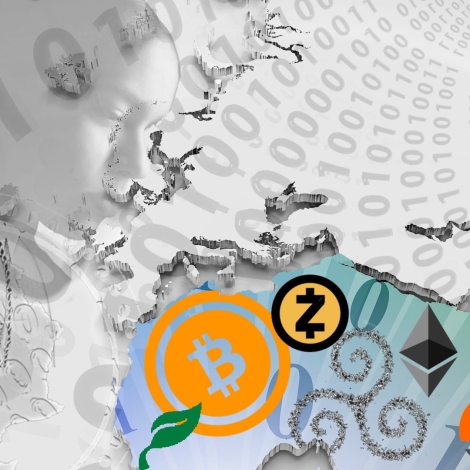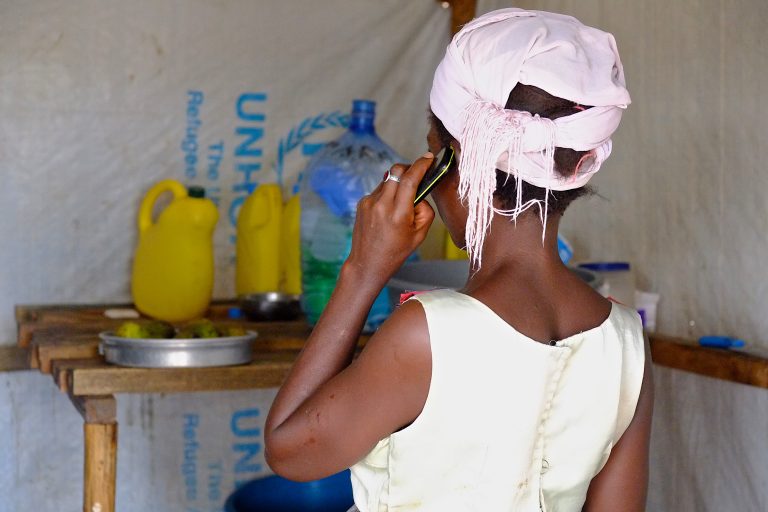The world is abuzz with blockchain. Financial service providers, governmental agencies and—most recently—humanitarian organizations are all investigating how blockchain and distributed ledger technology (DLT), generally, could improve operations.[1] [2] [3]
A Primer on Blockchain
Despite its popularity, many still wonder, what is blockchain? Put simply, a blockchain is a list maintained by a number of users without a central repository and, typically, without a central authority. The National Institute of Standards and Technology defines it as “[…any] immutable digital ledger [system] implemented in a distributed fashion.”[4] Though several types of chains exist, perhaps the best known is the public-permissionless blockchain, the technology popularized by Bitcoin, the world’s first cryptocurrency exchange.
The technologies underlying blockchain, including public key cryptography and blind signatures, have been fixtures of debate in Computer Science Departments and among cryptographers since at least the early 1980s[5] [6]. It wasn’t until 2009, however, when a publication on the topic gained widespread recognition: the whitepaper “Bitcoin: A Peer-to-Peer Electronic Cash System.”[7] Though the term does not appear in the whitepaper, it is described as “[…]an ongoing chain…that cannot be changed.”[8] Though bitcoin achieved fame and, not a bit of notoriety, within months of its 2009 release and 2010 valuation,[9] it took years for blockchain technology to achieve similar recognition. Even today, many still conflate bitcoin with blockchain, believing the latter to be a synonym for any kind of cryptocurrency. Skepticism about cryptocurrency still throws doubt on blockchain technology.
Though public-permissionless chains are common to financial services, many humanitarian organizations are opting for private-permissioned blockchains in which only authorized users can maintain the ledger.
Blockchain, however, is just one aspect of a cryptocurrency exchange. It serves as a record of exchange, enabling a number of parties to independently verify transaction claims; it is, in aim, to the cryptocurrency exchange what the double-entry logbook was to the early financial system: a means of distributing records of transactions across a number of parties.[10]
Like any technology, however, it is difficult to generalize about blockchain. There are several types of chains. The blockchain that underlies the bitcoin network, for instance, is public and permissionless, meaning that any user can add to or maintain the the ledger. Though public-permissionless chains are common to crypto exchanges and other financial services platforms, many humanitarian organizations are opting for private-permissioned blockchains. On private-permissioned chains, only authorized users can add to or maintain the ledger.
Blockchain in the Humanitarian Sector
In recent years, blockchain technology has mushroomed throughout the Humanitarian Sector. Innovations teams at Disberse, the World Food Programme, the International Federation of the Red Cross and Red Crescent Societies, and others, have begun exploring the value that the technology can bring to operations. Events like the Humanitarian Blockchain Summit, hosted by Fordham University, have begun to explore this expanding field of study and practice.
In recent years, blockchain technology has mushroomed throughout the Humanitarian Sector.
After undergoing proof of concept in Pakistan, the World Food Programme deployed blockchain technology for humanitarian aid in Jordan. In January 2017, Building Blocks registered the first Syrian refugees on a private-permissioned ethereum blockchain. To date, the program has reached over 100,000 refugees encamped in the Hashemite Kingdom. “Building Blocks” uses blockchain technology to record purchases at locally contracted merchants. It has reportedly reduced transaction costs by 98% by eliminating the use of local financial service providers; WFP remunerates merchants directly through electronic transfer. This process, recorded on a private-permissioned blockchain, resulted in an estimated $3.5 million in annual savings[11] [12]. Though the WFP blockchain has received widespread attention for improving the asset transfer program, similar functionality could have been achieved with traditional technologies and negotiation techniques. Indeed, as WFP program founder Haddad has commented, “[…]what we are doing now could be done on a traditional IT system.”[13]
Some of the most talked about uses of blockchain in the humanitarian sector include ‘smart’ contracts to secure forecast-based financing, a fully auditable direct funding platform, supply-chain tracking, and the tokenization of aid delivery.
Like the World Food Programme, Disberse has begun to explore applications of blockchain to humanitarian programming. A fund manager working to support humanitarian organizations, Disberse tokenizes currencies in an attempt to reduce transfer fees. By transforming currency (USD or GBP) into a digital fiat, Disberse attempts to disintermediate traditional financial service providers.[14] Disberse records every step of the transaction on a blockchain, enhancing the transparency of data collection and processing. In 2017, Disberse piloted its system by distributing funds from the UK to Swaziland. The funds supported local schools educating individuals orphaned by the HIV/AIDS epidemic. By tokenizing donations from the UK to Swaziland, Disberse reduced international transfer fees. With the money saved, the Swaziland NGO was able to educate an additional three students. The pilot demonstrated that Disberse could not only facilitate the transfer of aid at reduced cost (the service saved the donor 2.5 percent transfer fees) but also record transactions on an immutable digital ledger.[15]
Humanitarian Blockchain for Digital Identity
The potential uses of blockchain by humanitarian organizations are numerous. Some of the most talked about include the use of smart contracts to secure forecast-based financing arrangements, the deployment of a fully auditable direct funding platform, the implementation of supply chain tracking mechanisms, and the tokenization of aid delivery. Few, however, have reached pilot stage, and fewer still have entered programming. Perhaps none have received more attention than digital identity.
Today, over 1 billion individuals lack any form of official identification.[16] Without a recognized form of ID, these individuals are often unable to access government services and humanitarian aid. Obtaining identification can be time-intensive and cost-heavy. This gap is recognized by the United Nations Sustainable Development Goal 16.9, which seek to provide legal identity for all by 2030. Several organizations, governmental and non-governmental, are working towards this goal.
Today, over 1 billion individuals lack any form of official identification.
In a pilot in May 2018, the International Federation of the Red Cross began to design for digital identity, a term that has garnered much attention but drawn little agreement from experts. Digital identity, for the purposes of this article, can be defined as any metasystem of digital identifiers, bits and bytes of data accrued by an individual through interaction with others or institutions. Digital identity is often conflated with the movement for self-sovereign identity, which seeks to provide users control over their digital identifiers at a granular level across all interactions. Importantly, not all digital identity systems being piloted today adhere to the criteria of the self-sovereign identity community, nor do all operate under the aegis of “digital identity.” The term is still being established. What is relevant, however, is that these systems each attempt to shift control over a data metasystem to an individual.
In the context of humanitarian programming, digital identity could offer several benefits, including enhanced interoperability, intra-operability, auditability, and transparency. Each of these benefits take their root in providing individuals with control over their information, enabling them to determine what information they share and with whom. Though digital identity could offer each of these benefits, and more, it also poses serious threats to individual rights including the right to privacy, security, and choice.
Digital identity could offer enhanced interoperability, intra-operability, auditability, and transparency. It also poses serious threats to privacy, security, and choice.
Data collection and population management efforts have long posed threats to individual lives, particularly to those at the height of their vulnerability. These threats have engendered extreme reactions, like the burning of fingertips to avoid recognition by the EURODAC system. This phenomenon, known as systems avoidance, evinces the seriousness of the threat posed by any data management regime, digital identity included.[17] Though this article does not offer space for a full consideration of digital identity, its implications have been considered elsewhere. It is a growing field that needs more sustained focus and attention.[18]
In Spring 2018 in conjunction with the Kenya Red Cross Society, the International Federation of the Red Cross launched the Blockchain Pilot Project in Isiolo County, Kenya to pilot test digital identity. The organizations conducted an open-loop cash transfer program using a blockchain, developed by private sector-partner Red Rose, to record transactions. An answer to calls for drought relief, the Blockchain Pilot Project reached over two thousand households with cash disbursements. The blockchain enabled the Kenya Red Cross Society and International Federation of the Red Cross to secure a record of the program to a digital ledger. In addition to assisting beneficiaries, the Project also attempted to test blockchain technology for identification management.
Blockchain need only record a pseudonymous identifier corresponding to an individual activity. Thus, blockchain can facilitate interoperability, intra-operability, and auditability, without exposing an individual’s data.
The personal data of each beneficiary of the pilot was recorded in a proprietary database. Transaction information was written onto a blockchain. Both were accessible only to the Kenya Red Cross Society, the International Federation of the Red Cross, and private-sector partner RedRose. An interface developed by the third-party enabled the organizations to analyze the data aggregated on the blockchain.[19] A private key spawned for each beneficiary corresponded to an address on the chain, offering a rudimentary digital identity to each beneficiary. Though beneficiaries were not in control of their interactions, the generation of a public-private key pair can be understood as a first step towards developing a robust digital identity system. In the future, the Kenya Red Cross Society and International Federation of the Red Cross will seek to extend digital identities to individuals without identification.
Several aspects of blockchain technology make it conducive to facilitating digital identity. Blockchain technology is fundamentally about governance. It can enable distributed governance amongst actors without necessitating point-to-point trust agreements or read access to individual data. Instead, a blockchain need only record a pseudonymous identifier corresponding to an individual activity. Thus, blockchain can facilitate interoperability, intra-operability, and auditability, without exposing an individual’s data. And, through technologies layered on top of blockchain, individuals can control the sharing of their data at a granular level, exposing only minimally viable information through a process known as a zero knowledge proof. Though this article does not offer space for a full consideration of digital identity and blockchain, more can be found here[20].
Blockchain technology is being piloted for individuals by humanitarian organizations today. Its implications are vast and are only know being considered.
Though all forms of identification are capable of conferring both access and risk on its bearer, identification systems for communities at the height of their vulnerability deserve special attention. Blockchain technology is being piloted for individuals by humanitarian organizations today. Its implications are vast and are only know being considered. Use-cases like digital identity deserve careful consideration and widespread attention.
References
[1] UN Office for the Coordination of Humanitarian Affairs, Blockchain for the Humanitarian Sector: Future Opportunities
[2] UN Blockchain, Blockchain for Humanity
[3] Forbes, Humanitarian Blockchain: Coding for a Humane, Sustainable World
[4] U.S. Department of Commerce, Blockchain Technology Overview (pdf)
[5] David Chaum, Achieving Electronic Privacy (pdf)
[6] David Chaum, Computer Systems Established, Maintained, and Trusted by Mutually Suspicious Groups (pdf)
[7] Satoshi Nakamoto, Bitcoin: A Peer-to-Peer Electronic Cash System (pdf)
[8] Ibid
[9] Bernard Marr, A Short History of Bitcoin and Crypto Currency Everyone Should Read
[10] Fintastico, From Double Entry Bookkeeping to the Blockchain
[11] World Food Programme, Building Blocks The Future of Cash Disbursements at the World Food Program (pdf)
[12] Datarella, Building the Industrial Blockchain
[13] See comments in: David Gerard, The World Food Programme’s much-publicised “blockchain” has one participant – i.e., it’s a database
[15] Start Network, Start Network in new partnership with Disberse to test revolutionary technology
[16] World Bank ID4D, Identification for Development Global Dataset
[17] Brayne, BLANK
[18] Please see “Distributed-ledger identification systems in the humanitarian sector,” Sovrin (to be released)
[19] Blockchain Open Loop Cash Transfer Pilot Project (pdf)
[20] Please see “Distributed-ledger identification systems in the humanitarian sector,” Sovrin (to be released)

